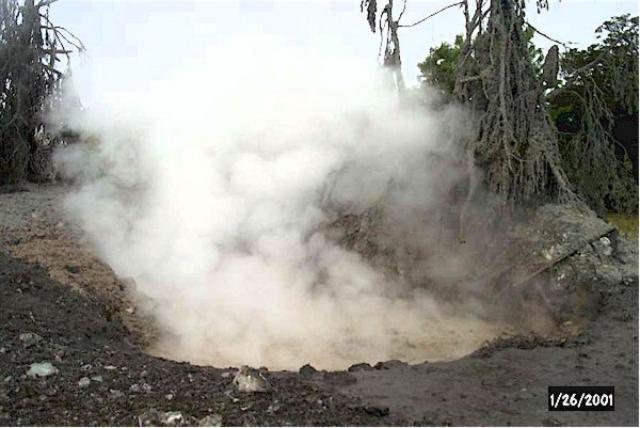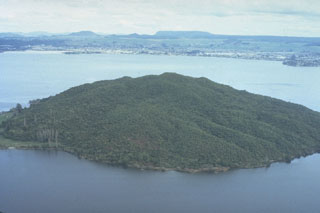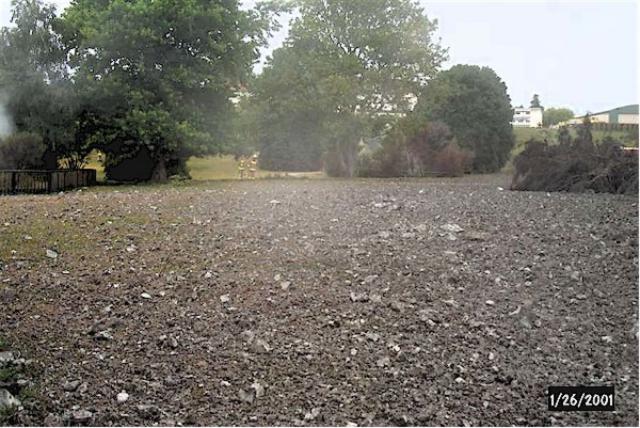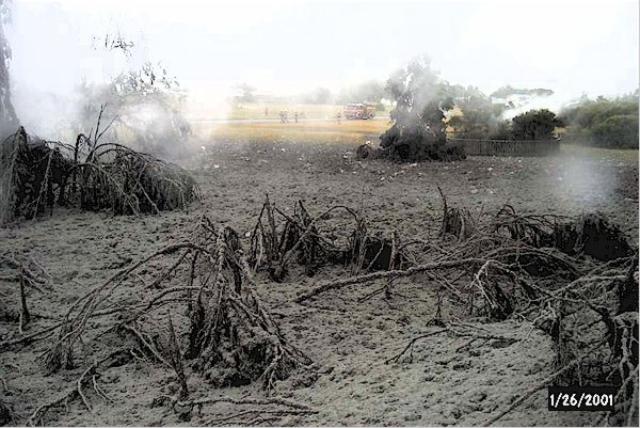Report on Rotorua (New Zealand) — March 2001
Bulletin of the Global Volcanism Network, vol. 26, no. 3 (March 2001)
Managing Editor: Richard Wunderman.
Rotorua (New Zealand) Hydrothermal eruption on 26 January ejects mud and ballistic blocks
Please cite this report as:
Global Volcanism Program, 2001. Report on Rotorua (New Zealand) (Wunderman, R., ed.). Bulletin of the Global Volcanism Network, 26:3. Smithsonian Institution. https://doi.org/10.5479/si.GVP.BGVN200103-241816
Rotorua
New Zealand
38.08°S, 176.27°E; summit elev. 757 m
All times are local (unless otherwise noted)
On 26 January, from 1530 to 1540, Spring 721 (figure 2), a muddy hot pool ~2.5-3.0 m in diameter, generated the largest hydrothermal eruption in Kuirau Park since 1966. Blocks and other ejecta rose as high as ~100 m and produced a thick deposit extending more than 120 m E of the vent (figure 3). Blocks up to 1 m in diameter were thrown 50 m from the vent, while smaller blocks less than 0.1 m in diameter landed 100 m away. Ejecta reached less than 30 m to the W. The resultant crater had a diameter of 10-12 m.
 |
Figure 2. Spring 721 steaming shortly after the Rotorua mud eruption. Note ejected mud and blocks, and mud-coated, damaged vegetation in the background. Courtesy of Brad Scott. |
Four distinct deposits from the eruption were recognizable on the evening of 26 January. The first unit was a dark gray hydrothermal mud spilt onto an adjacent road W of the vent. This mud appeared to be the pre-eruption contents of Spring 721. A ballistic block bed was the most widely distributed unit, and was composed almost entirely of rocks from the Oranui Formation. Ballistic blocks were found overlying the mud deposits as well as lower down in the sequence coated by mud with sheltered zones on the leeward sides; this indicated that block ejection was active throughout the eruption. A widespread dark gray mud was deposited SE of the vent with a thickness ranging from 400 mm to only a few millimeters at Ranolf Street. A smaller, slightly darker, gray mud deposit E of the vent, overlayed the prior mud with a maximum thickness of 100-150 mm.
The main phase of the eruption was inferred to be followed by a smaller mud-rich shower, preceded by distinct ejection of centimeter-sized ballistic blocks that impacted into all of the mud deposits. These blocks extended well beyond the mud NE of the vent, and their relationship to the mud deposits could not be clearly determined. Mud fallout coated trees and shrubs within the ejecta apron, bending and breaking many of them (figure 4).
References. Wilson, C.J.N., Rogan, A.M., Smith, I.E.M., Northey, D.J., Nairn, I.A., Houghton, B.F., 1984, Caldera volcanoes of the Taupo volcanic zone, New Zealand: Journal of Geophysical Research, B, v. 89, no. 10, p. 8463-8484.
Wilson, C.J.N., Houghton, B.F., McWilliams, M.O., Lanphere, M.A., Weaver, S.D., Briggs, R.M., 1995, Volcanic and structural evolution of the Taupo volcanic zone, New Zealand; a review: Journal of Volcanology and Geothermal Research, v. 68, no. 1-3, p. 1-28.
Geological Summary. The 22-km-wide Rotorua caldera is the NW-most caldera of the Taupo volcanic zone. It is the only single-event caldera in the Taupo Volcanic Zone and was formed about 220,000 years ago following eruption of the more than 340 km3 rhyolitic Mamaku Ignimbrite. Although caldera collapse occurred in a single event, the process was complex and involved multiple collapse blocks. The major city of Rotorua lies at the south end of the lake that fills much of the caldera. Post-collapse eruptive activity, which ceased during the Pleistocene, was restricted to lava dome extrusion without major explosive activity. The youngest activity consisted of the eruption of three lava domes less than 25,000 years ago. The major thermal areas of Takeke, Tikitere, Lake Rotokawa, and Rotorua-Whakarewarewa are located within the caldera or outside its rim, and the city of Rotorua lies within and adjacent to active geothermal fields.
Information Contacts: Brad Scott, Wairakei Research Center, Institute of Geological and Nuclear Sciences (IGNS), Private Bag 2000, Taupo, New Zealand (URL: http://www.gns.cri.nz/).



